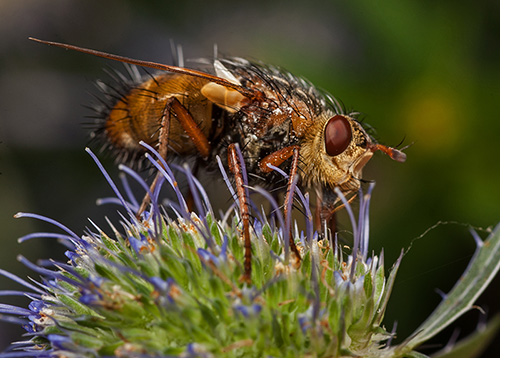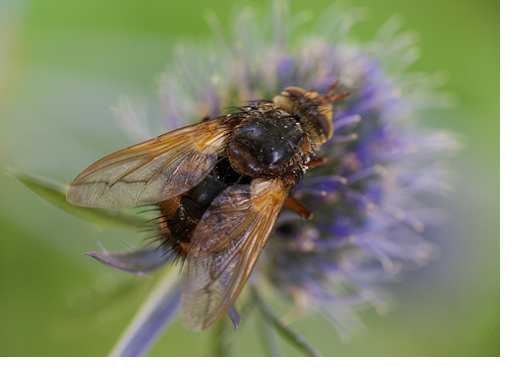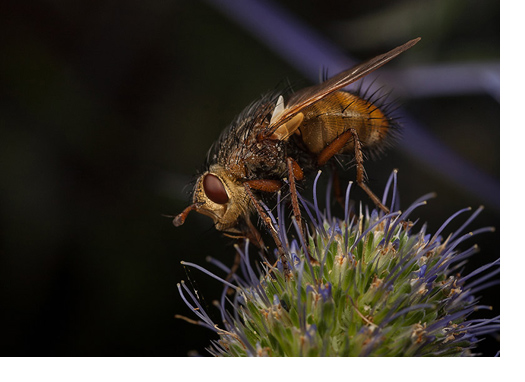Big, Bold & Bristly - a Garden Tachinid Fly
10th September 2012
In: September 2012
 It's always satisfying to find a new garden "first", and when I saw this large bristly fly feeding on Eryngium flowers, I guessed I had my first garden tachinid. The Tachinidae is a family of parasitic flies that attack the larvae of their "host" insects; often the caterpillars of butterflies and moths. Some species parasitise other insects, including beetles, true bugs, plant hoppers and sawflies. Interestingly, it's rare for them to attack other fly species.
It's always satisfying to find a new garden "first", and when I saw this large bristly fly feeding on Eryngium flowers, I guessed I had my first garden tachinid. The Tachinidae is a family of parasitic flies that attack the larvae of their "host" insects; often the caterpillars of butterflies and moths. Some species parasitise other insects, including beetles, true bugs, plant hoppers and sawflies. Interestingly, it's rare for them to attack other fly species.Female adult tachinids have a variety of methods for parasitising their hosts. Some stab eggs into their host using a special dagger-like organ, some lay an egg on the exterior of the host (in a position where it is difficult to remove), some lays eggs on the host's food plant (after hatching the larvae wait for the host and then attach themselves and burrow inside). Whatever the method, the developing stage of the tachinid will consume the "prey" from the inside; eventually killing it. Because its host is invariably killed during the process, tachinids should more accurately be described as parasitoids, rather than parasites.
 This particular tachinid fly looks like Tachina fera. It's large (> 10mm), robust and bristly. The wings are yellowish towards the base and from above; the abdomen is orange with a thick, central black line. Like other parasitic flies I've photographed, this fly was also very tolerant and allowed me to hold and position the flower it was on, without flying off.
This particular tachinid fly looks like Tachina fera. It's large (> 10mm), robust and bristly. The wings are yellowish towards the base and from above; the abdomen is orange with a thick, central black line. Like other parasitic flies I've photographed, this fly was also very tolerant and allowed me to hold and position the flower it was on, without flying off.Because of this tolerance (and its decision to remain feeding for over 30 minutes), I was able to experiment with and compare, different photographic techniques. Those who may have read earlier Blog posts, will know that I prefer using flash for insect photography. There are various reasons for this and I plan to write about this in more detail during the winter months. Primarily, flash allows greater depth-of field (I usually use up to F11 or F13). Typically, I would attach my Twinlite flash, set my camera mode to Manual, dial in my preferred aperture setting and a shutter setting set to the camera's flash-synch speed (1/200th second on my Canon 5D or 1/250th second on my 1D). ISO is set to 100. This gives a low-noise image with good depth-of field (DoF) and at a speed that enables hand-holding. The drawbacks can include "glare" from the flash and because of light falloff (read about the inverse square law for more details!), the background can be under-exposed or totally black.
 The image top-left was one of my first shots. It's totally flash-lit and there is some reflected light from the fly. You may say it's too harsh and I would tend to agree. There is good detail though and at F13, reasonable DoF. Post-processing was used to reduce some of the glare/highlights. The next shot (centre left) was taken without flash. The camera was in aperture-priority mode. I set the aperture to F7.1 for this shot and even at ISO 800, was only getting 1/50th second shutter speed. That's too slow really and camera shake is evident. The overall "look" is much different; more evenly illuminated. The DoF is very shallow though, but does show the abdominal stripe that I wanted. I could have opened up the aperture by 1 stop (to F5) and this would have reduced the shutter speed to 100th second. Better for handholding, but with DoF even further reduced. It's all a matter of compromising one thing for another.
The image top-left was one of my first shots. It's totally flash-lit and there is some reflected light from the fly. You may say it's too harsh and I would tend to agree. There is good detail though and at F13, reasonable DoF. Post-processing was used to reduce some of the glare/highlights. The next shot (centre left) was taken without flash. The camera was in aperture-priority mode. I set the aperture to F7.1 for this shot and even at ISO 800, was only getting 1/50th second shutter speed. That's too slow really and camera shake is evident. The overall "look" is much different; more evenly illuminated. The DoF is very shallow though, but does show the abdominal stripe that I wanted. I could have opened up the aperture by 1 stop (to F5) and this would have reduced the shutter speed to 100th second. Better for handholding, but with DoF even further reduced. It's all a matter of compromising one thing for another.For the next image (bottom left) I turned the flash back on and reset the camera as earlier; (M)anual, F13, 1/200th second. This time though I added additional "diffusion" to the flash heads by simply pushing some polystyrene drinking cups on them. Not very scientific (or pretty), but I've found that it works! Very "flightly" insects are often frightened off but it's good for shiny beetles and bolder flies etc. Reflections are lessened but so is background illumination. This can be controlled by the positioning of background objects or by using another flash, "slaved" of the master flash. More difficult to arrange though, depending on circumstances and the cooperation of the subject! I quite like the overall appearance of this image. The fly is sharp and reasonably-well-illuminated. The background is dark, but not totally black. It's all a matter of taste I suppose.
Comments
 By Lucy Corrander: It's an interesting article - both about the fly and the photography. It's interesting that you are able to use a flash without frightening the fly. I don't take very sophisticated insect pictures but have found I must keep my shadow away. If the shadow touches a fly or bee - off it goes. Is it that your fly was specially tolerant or that a fly is less disturbed by a blast of light than a flicker of shade?
By Lucy Corrander: It's an interesting article - both about the fly and the photography. It's interesting that you are able to use a flash without frightening the fly. I don't take very sophisticated insect pictures but have found I must keep my shadow away. If the shadow touches a fly or bee - off it goes. Is it that your fly was specially tolerant or that a fly is less disturbed by a blast of light than a flicker of shade?